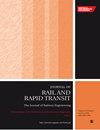Expert system based fault diagnosis for railway point machines
IF 2.1
4区 工程技术
Q3 ENGINEERING, CIVIL
Proceedings of the Institution of Mechanical Engineers Part F-Journal of Rail and Rapid Transit
Pub Date : 2023-11-04
DOI:10.1177/09544097231195656
引用次数: 0
Abstract
To meet the increasing demands for availability at reasonable cost, operators and maintainers of railway point machines are constantly looking for innovative techniques for switch condition monitoring and prediction. This includes automated fault root cause diagnosis based on measurement data (such as motor current curves) and other information. However, large, comprehensive sets of labeled data suitable for standard machine learning are not yet available. Existing data-driven approaches focus only on the differentiation of a few major fault categories at the level of the measurement data (i.e., the “fault symptoms”). There is great potential in hybrid models that use expert knowledge in combination with multiple sources of information to automatically identify failure causes at a much more detailed level. This paper discusses a Bayesian network diagnostic model for determining the root causes of faults in point machines, based on expert knowledge and few labeled data examples from the Netherlands. Human-interpretable current curve features and other information sources (e.g., past maintenance actions) are used as evidence. The result of the model is a ranking of the most likely failure causes with associated probabilities in terms of fuzzy multi-label classification, which is directly aimed at providing decision support to maintenance engineers. The validity and limitations of the model are demonstrated by a scenario-based evaluation and a brief analysis using information theoretic measures. We present the information sources used, the detailed development process and the analysis methodology. This article is intended to be a guide to developing similar models for various complex technical assets.基于专家系统的铁路机车故障诊断
为了满足日益增长的对合理成本可用性的需求,铁路点机运营商和维护人员不断寻求创新的开关状态监测和预测技术。这包括基于测量数据(如电机电流曲线)和其他信息的自动故障根本原因诊断。然而,适合标准机器学习的大型,全面的标记数据集尚未可用。现有的数据驱动方法只侧重于在测量数据层面上区分几个主要故障类别(即“故障症状”)。混合模型将专家知识与多个信息源相结合,在更详细的层面上自动识别故障原因,这种混合模型具有很大的潜力。本文讨论了一种基于专家知识和来自荷兰的少量标记数据示例的贝叶斯网络诊断模型,用于确定点机器故障的根本原因。人类可解释的电流曲线特征和其他信息源(例如,过去的维护行动)被用作证据。该模型的结果是基于模糊多标签分类的最可能的故障原因与相关概率的排序,直接目的是为维护工程师提供决策支持。通过基于场景的评估和信息理论的简要分析,证明了该模型的有效性和局限性。我们介绍了所使用的信息来源,详细的开发过程和分析方法。本文旨在指导为各种复杂的技术资产开发类似的模型。
本文章由计算机程序翻译,如有差异,请以英文原文为准。
求助全文
约1分钟内获得全文
求助全文
来源期刊

CiteScore
4.80
自引率
10.00%
发文量
91
审稿时长
7 months
期刊介绍:
The Journal of Rail and Rapid Transit is devoted to engineering in its widest interpretation applicable to rail and rapid transit. The Journal aims to promote sharing of technical knowledge, ideas and experience between engineers and researchers working in the railway field.
 求助内容:
求助内容: 应助结果提醒方式:
应助结果提醒方式:


